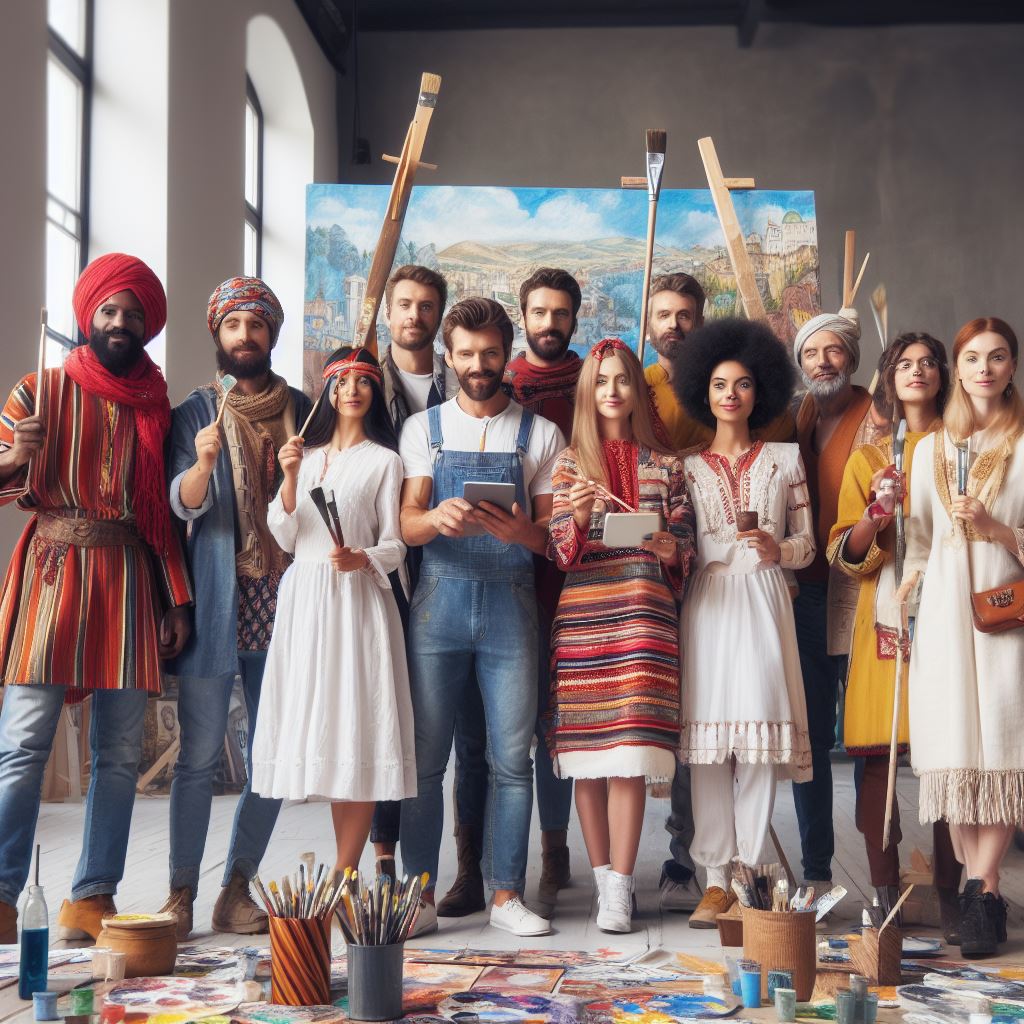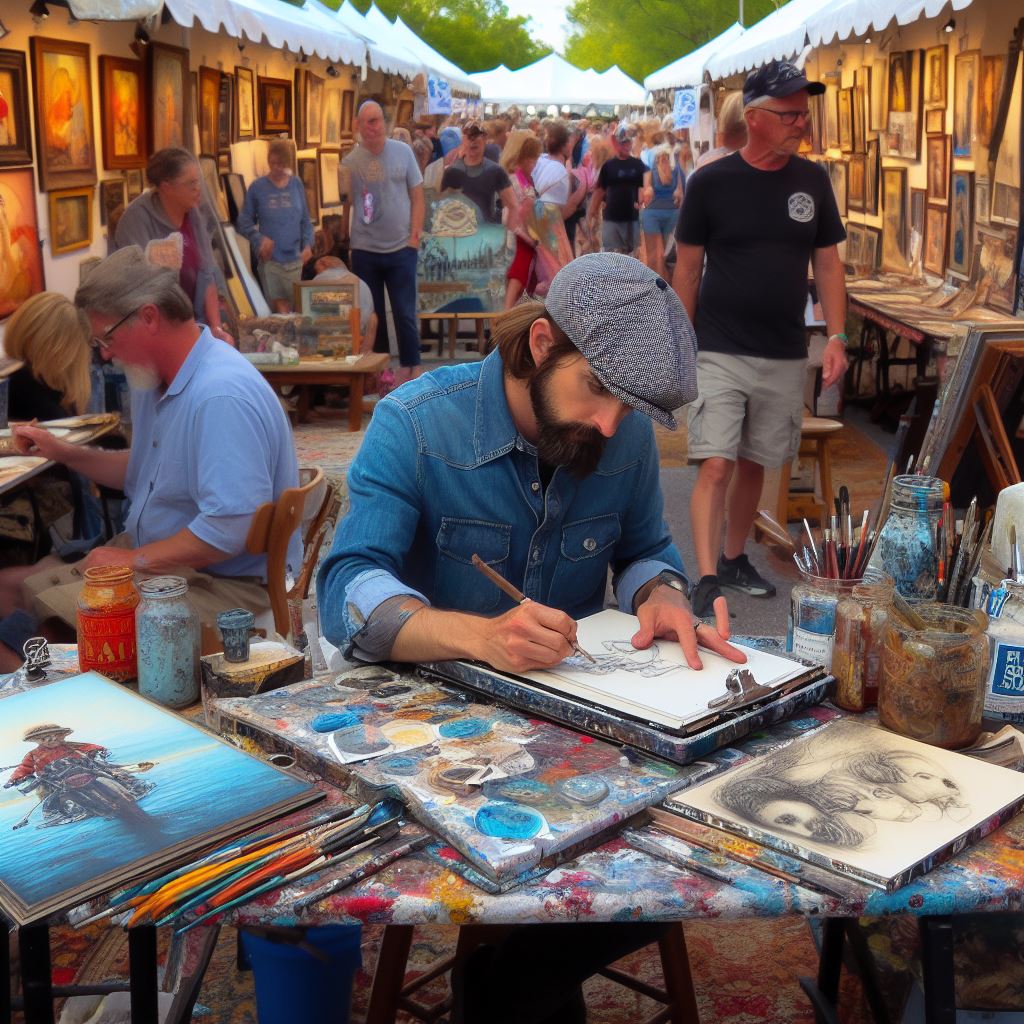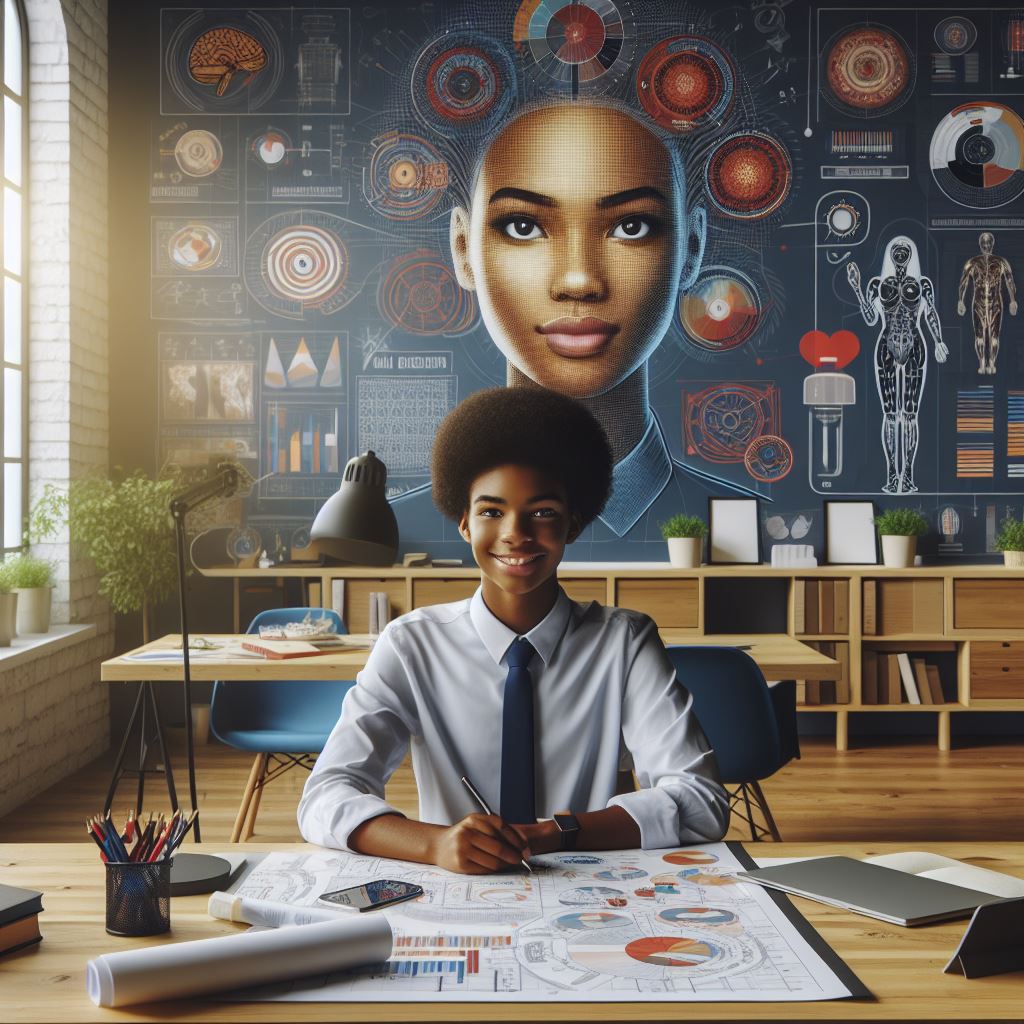Introduction
Artist’s role plays a crucial part in American society, leaving a significant impact on culture and society.
Through their creativity and expression, artists have the power to inspire, provoke thought, and challenge societal norms.
This blog post explores the importance of their role and the influence they have on shaping American society.
Artists are the driving force behind cultural transformation, using their talents to reflect the world around them.
Their work provides a lens through which society can view and understand diverse perspectives, shining a light on social issues, politics, and personal experiences.
By amplifying voices that may otherwise go unheard, artists bring about social awareness and change.
The artist’s role extends beyond mere entertainment in American society; it is about fostering conversations, challenging assumptions, and pushing boundaries.
Through their art, they challenge society to question the status quo, encouraging new ways of thinking and opening doors to alternative narratives and ideas.
Their creations serve as a catalyst for dialogue, sparking discussions that can lead to societal progression.
Furthermore, artists have the ability to preserve history and culture, capturing the essence of a particular time or place through their work.
They document the struggles, triumphs, and nuances of the American experience, creating a lasting legacy for future generations.
Their art acts as a time capsule, providing a window into the past and shaping the collective memory of a nation. In this blog post, we will explore the multifaceted role of the artist in American society.
We will delve into the impact artists have on culture and society, examining how their work fosters dialogue, challenges societal norms, and preserves the essence of the American experience.
Join us as we celebrate and explore the transformative power of art and the artist’s indelible mark on American society.
The definition of the artist
Artists are individuals who create art, often in the form of visual, performing, or literary arts. They use their creativity and skills to express ideas, emotions, and concepts through their work.
Different forms of art
- Visual arts include painting, sculpture, photography, drawing, and mixed media.
- Performing arts encompass dance, theater, music, and film.
- Literary arts involve writing, including poetry, novels, essays, and short stories.
How artists contribute to American society through their creative expressions
1. Artists provide cultural representation
- They reflect and represent the diverse experiences, values, and perspectives of American society.
- Through their art, they give a voice to marginalized communities and amplify social issues.
2. Artists foster creativity and critical thinking
- By pushing boundaries and exploring new ideas, artists inspire innovation across various fields.
- Their work challenges existing norms, encourages independent thinking, and promotes intellectual growth.
3. Artists promote emotional and psychological well-being
- Art has a therapeutic effect and can evoke powerful emotions, providing catharsis and healing.
- Artists create work that resonates with individuals, offering solace, comfort, and a sense of connection.
4. Artists contribute to the economy
- The art industry generates significant revenue through the sale of artworks, exhibitions, and performances.
- Artists create job opportunities in supporting roles and contribute to tourism by attracting visitors.
5. Artists contribute to education and learning
- Art education fosters creativity, self-expression, and critical thinking skills in students.
- Artists often teach and mentor others, passing on their knowledge, techniques, and insights.
6. Artists drive cultural innovation
- By challenging conventional norms, artists push society to question existing beliefs and structures.
- Their work initiates conversations, triggers change, and contributes to the evolution of cultural identity.
7. Artist’s advocate for social change
- Through their art, artists become catalysts for social justice, equality, and activism.
- They raise awareness about societal issues, challenge stereotypes, and promote inclusive dialogues.
8. Artists preserve and celebrate cultural heritage
- Artist’s honor cultural traditions, preserving and documenting history for future generations.
- They create works that celebrate diversity, multiculturalism, and the rich tapestry of American society.
In essence, artists play a crucial role in American society. Through their various forms of art, they contribute to cultural representation, creativity, emotional well-being, the economy, education, cultural innovation, social change, and the preservation of cultural heritage.
Their creative expressions have a profound impact on individuals, communities, and the nation as a whole.
Read: Pioneers of Graphic Design: US Icons and Their Legacies
Historical perspective
American art history is a vibrant tapestry, evolving from colonial times to today, shaping society profoundly.
Early settlers introduced European traditions, emphasizing religious themes and portraiture.
Transform Your Career Today
Unlock a personalized career strategy that drives real results. Get tailored advice and a roadmap designed just for you.
Start NowIconic artist Gilbert Stuart, renowned for capturing figures like George Washington, left an indelible mark, embodying the American Revolution’s spirit.
The mid-19th century saw the emergence of the Hudson River School, with artists Thomas Cole and Frederic Edwin Church celebrating the American landscape.
In the 20th century, the modern art movement, led by Jackson Pollock and Mark Rothko, challenged traditions, laying the foundation for a new era.
Pop art, epitomized by Andy Warhol and Roy Lichtenstein, embraced mass culture, reflecting the influence of media on American society.
The civil rights movement spurred artists like Romare Bearden and Jacob Lawrence to address social injustices through their work.
In recent times, street art, epitomized by Banksy, challenges traditional boundaries and makes powerful political and social statements.
Famous American artists transcend the art world, influencing fashion, music, and design. Keith Haring and Jean-Michel Basquiat, for instance, left an enduring mark on streetwear and urban aesthetics.
These artists, shaping public spaces with murals and sculptures, contribute to a collective sense of identity and community.
In review, American art, diverse and dynamic, reflects and shapes the cultural landscape, inspiring generations to see the world creatively.
Read: The Influence of Pop Culture on US Graphic Design Trends
Cultural Impact of Artists
Artists have played a significant role in shaping and influencing American culture throughout history.
From visual arts to music, literature, and film, their creations reflect and shape the values and beliefs of society in various ways.
This blog section will analyze the profound impact of artist’s role on American society and discuss how art reflects and shapes societal values and beliefs.
Artists as Cultural Influencers
Artists have the ability to challenge societal norms through their creations, sparking conversations and igniting change.
Visual Arts and Social Commentary
Paintings and sculptures often serve as powerful social commentary, highlighting important issues and challenging the status quo.
Music and Expression of Identity
Musicians have been instrumental in expressing and shaping American identities, from blues and jazz to rock, hip-hop, and beyond.
Literature and the Exploration of Human Experience
Writers delve into the depths of the human experience, allowing readers to connect and empathize with diverse perspectives.
Film as a Mirror of Society
Movies capture the essence of society, reflecting its flaws, progress, and collective experiences on the big screen.
Art as a Medium for Political Activism
Artists have frequently used their platforms to advocate for social and political change, giving voice to the marginalized.
Showcase Your Business Today
Reach thousands of readers actively exploring professional services. Publish your business profile and grow your audience now.
Publish NowArt as a Catalyst for Social Movements
Throughout history, art has been a driving force behind various social movements, inspiring activism and bringing about societal transformations.
The Influence of Art on Fashion and Design
Artistic expressions influence fashion, interior design, and architecture, shaping aesthetic preferences and challenging traditional norms.
Art as a Vehicle for Cultural Preservation
The Art plays a vital role in preserving cultural heritage, ensuring that traditions and identities are not forgotten or lost.
Art as Therapy and Emotional Well-being
Engaging in artistic activities has been proven to promote emotional well-being, providing an outlet for self-expression and healing.
Art as an Agent of Change in Education
Art education fosters creativity, critical thinking, and cultural appreciation, promoting well-rounded individuals and an inclusive society.
The Intersection of Art and Technology
Advancements in technology have expanded artistic possibilities, allowing for innovative mediums and immersive experiences.
Art helps shape a nation’s identity, celebrating its uniqueness and influencing how it is perceived globally.
Art Education’s Role in Empowering Future Artists
Nurturing young artistic talent through education empowers future artists to continue shaping and influencing American culture.
The Importance of Supporting Artists
Supporting artists financially and artistically ensures their continued ability to impact society and contribute to cultural development.
Generally, artist’s role and their creations have consistently influenced and shaped American society and culture.
From visual arts to music, literature, film, and beyond, art serves as a reflection of society while also pushing boundaries and sparking change.
By analyzing the cultural impact of artists and understanding how art reflects and shapes societal values and beliefs, we can appreciate and support the invaluable role that artists play in American society.
Read: Sustainability in Design: A Growing Trend in the US

Economic impact
The arts industry profoundly impacts the American economy. Artists generate income, creating job opportunities and supporting related sectors like galleries and theaters.
Consumer spending on tickets, art supplies, and merchandise boosts revenue, contributing to businesses and government tax income.
The arts industry fosters cultural tourism, attracting global visitors and stimulating demand for accommodation, transportation, and related services.
Despite economic contributions, artists face financial challenges, including inconsistent income and high living costs, hindering their ability to create and showcase work.
Traditional financial support, such as grants, is highly competitive, limiting artists’ access to funds for projects.
The digital age and technology disrupt traditional revenue streams, making it challenging for artists to protect their work and receive proper compensation.
Essentially, while the arts industry significantly impacts the economy, artists confront financial challenges like inconsistent income and the impact of technology on revenue streams.
Addressing these challenges is crucial for sustainability.
Read: Navigating Copyright Laws for Designers in the USA
Social commentary through art
Artists have always used their platform to comment on societal issues. Through their creativity and unique perspectives, they have an unparalleled ability to provoke thought, elicit emotions, and challenge the status quo.
In this blog section, we will explore how artists have been catalysts for change and expression, highlighting their importance in American society.
Artists as mirrors of society
Artists have a keen eye for observing and interpreting the world around them. They reflect the struggles, triumphs, and complexities of the human experience.
By capturing and showcasing various aspects of society, artists serve as mirrors that allow us to reflect upon ourselves.
Advocating for change
Artists often utilize their work to advocate for social and political change. By addressing societal issues, such as inequality, discrimination, or environmental concerns, they raise awareness and inspire action.
Through their art, they amplify voices that may not otherwise be heard, ensuring marginalized communities are seen and understood.
Shattering stereotypes and challenging norms
Artists have the power to challenge societal norms and reshape our perspectives. They break stereotypes and challenge prejudices through their creative expressions.
By presenting alternative narratives, they broaden our understanding of different cultures, identities, and viewpoints.
Sparking dialogue and discussion
Art serves as a catalyst for meaningful conversations and dialogue. It prompts viewers to question, debate, and engage with important societal issues.
Museums, galleries, and public installations become spaces for communal reflection and exchange of ideas.
Engaging emotions and empathy
Artists have a unique ability to evoke emotions and create empathy. By presenting powerful visual representations of human experiences, they foster empathy and understanding.
This emotional connection encourages viewers to connect with the subject matter on a personal level.
Inspiring hope and resilience
In times of crisis or turmoil, artists often emerge as beacons of hope. Through their work, they remind us of our resilience and capacity for change.
Art can provide solace, inspiration, and a sense of unity, bringing people together in times of need.
Redefining cultural narratives
Artist’s challenge and redefine cultural narratives that may be limiting or outdated. They introduce new perspectives, reinterpret history, and explore personal and collective identities.
This process of reevaluation and reimagining helps us to evolve as a society.
Fostering inclusivity and diversity
Artists actively contribute to creating a more inclusive and diverse society. By representing a wide range of cultures, experiences, and voices, they foster understanding and celebrate diversity.
This representation encourages dialogue and strengthens social cohesion.
Showcase Your Business Today
Reach thousands of readers actively exploring professional services. Publish your business profile and grow your audience now.
Publish NowEssentially, artist’s role is a crucial part in the American society, using their platform to comment on societal issues, advocate for change, and challenge long-standing norms.
Their ability to spark dialogue, evoke emotions, and inspire hopes makes them catalysts for social and cultural transformation.
As we navigate an ever-changing world, art serves as an important reminder of our shared humanity, reminding us of the power of creativity and expression in shaping our society.
Gain More Insights: Skill Sets Employers Seek in US-Based Animation Artists
See Related Content: How to Price Your Services as a Web Designer
Uncover the Details: How to Get Clients as a Freelance Advertising Designer
See Related Content: How to Improve Your Concept Art Techniques Quickly
Challenges Faced by Artists
Numerous obstacles hinder artists in American society‘limited finances restrict creative pursuits, while lack of recognition affects motivation.
Societal expectations demand conformity, challenging artistic individuality. Balancing art with financial stability poses constant challenges in the competitive industry.
Artists confront skepticism and criticism, undermining confidence. Fluctuating demand and cultural shifts complicate making a living.
Navigating legalities, copyright issues, and contracts proves challenging. Limited access to affordable studios hampers productivity. Validation pressures persist.
Representation gaps create barriers for marginalized artists. Resistance surfaces when challenging norms or addressing controversial topics.
Financial stability often leads to compromising artistic integrity for commercial success. Juggling roles in marketing and administration overwhelms artists.
Emotional vulnerability and self-doubt plague artists exposing inner creativity. Balancing personal fulfillment with market demands is challenging.
Access to healthcare, insurance, and retirement benefits remains difficult. Building a network and industry connections requires significant time and effort.
Addressing the Need for Support Systems and Resources
Implementing support systems and resources contributes to artists’ success. Financial grants, scholarships, and funding alleviate constraints.
Artist-in-residence programs enhance studio access. Mentorship programs guide and inspire emerging talents.
Advocating for diversity breaks barriers. Educational initiatives equip artists with skills. Partnerships with local businesses offer mutual support.
Promoting art appreciation nurtures future artists. Fair exhibition systems ensure equal opportunities.
Legal support helps navigate copyright issues. Tailored healthcare plans are crucial.
Platforms like galleries enhance exposure. Collaboration with policymakers supports artists’ rights.
Strengthening unions amplifies the collective voice. Emphasizing art’s importance fosters public support.
Recognizing artists through awards boosts morale. Encouraging investment creates sustainable opportunities.
Regularly evaluating systems ensures effectiveness.
By acknowledging and addressing the challenges faced by artists and providing them with the necessary support systems and resources, American society can foster a thriving artistic community that enriches our cultural landscape and empowers artists to fully express their creative visions.
Conclusion
The artist’s role in American society is of great importance. They have the power to inspire, critique, and challenge societal norms.
Through their work, they can provoke thought, spark conversations, and promote cultural change.
Artist’s role have the ability to shape American culture and society by pushing boundaries, representing diverse perspectives, and addressing relevant issues.
In the future, artists will continue to play a significant role in shaping American culture.
They will have the potential to influence social movements, challenge political ideologies, and advocate for marginalized communities.
With the advancements in technology and globalization, artists will have even more platforms to showcase their work and reach a wider audience.
They can leverage their artistic expressions to bridge gaps between different communities, ignite social change, and create a more inclusive and interconnected society.
Additionally, artists can contribute to the development of new art forms and mediums, opening up new possibilities for creative expression.
The future impact of artists in shaping American culture and society is immense, as they possess the ability to challenge existing narratives, bring about cultural shifts, and shape the collective consciousness of the nation.
By embracing and supporting artists, American society can thrive creatively, intellectually, and emotionally.
It is crucial to recognize and empower artists, as they are essential in creating a vibrant, diverse, and progressive society.
[E-Books for Sale]
The Big Book of 500 High-Paying Jobs in America: Unlock Your Earning Potential
$19.99 • 500 High-Paying Jobs • 330 pages
Explore 500 high-paying jobs in America and learn how to boost your career, earn more, and achieve success!
See All 500 High-Paying Jobs of this E-Book
1001 Professions Without a Degree: High-Paying American Jobs You Can Start Now
$19.99 • 1001 Professions Without a Degree • 174 pages
Discover 1001 high-paying jobs without a degree! Unlock career tips, skills, and success strategies for just $19.99!




